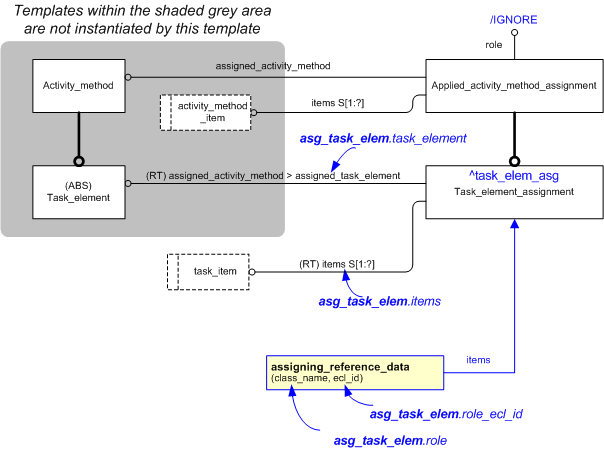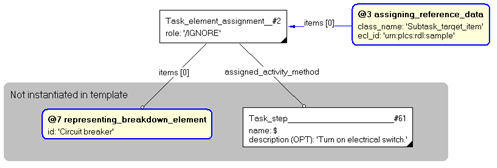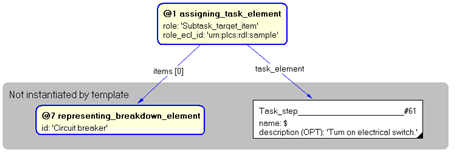
| Template:— assigning_task_element (asg_task_elem) Capability:representing_task |
Date: 2009/03/11 08:57:22 Revision: 1.4 |
This section specifies the template assigning_task_element.
NOTE The template has been defined in the context of the capability representing_task which provides an overall description of the relevant parts of the ISO 10303-239 information model and a description of related templates.
NOTE An explanation of a template and the associated instantiation path is provided in the Template overview section.
This template describes how to represent the assignment of a Task_element to another item in the model.


target
is the parameter to which the
Task_element_assignment
is bound.
| Entity in path | Value | Inherited from |
| Task_element_assignment.role | '/IGNORE' | Applied_activity_method_assignment.role |

The instance model in STEP XML exchange file format (ISO 10303 Part 28 ed.2 syntax) is:#2 = TASK_ELEMENT_ASSIGNMENT(#61,(#29),'/IGNORE'); #4 = CLASSIFICATION_ASSIGNMENT(#5,(#2),'/IGNORE'); #5 = EXTERNAL_CLASS('/NULL','Subtask_target_item','/IGNORE',#6); #6 = EXTERNAL_CLASS_LIBRARY('urn:plcs:rdl:sample','/IGNORE'); #8 = BREAKDOWN_ELEMENT('/IGNORE','/IGNORE','/IGNORE'); #10 = IDENTIFICATION_ASSIGNMENT('Circuit breaker','/IGNORE','/IGNORE',(#8)); #12 = CLASSIFICATION_ASSIGNMENT(#13,(#10),'/IGNORE'); #13 = EXTERNAL_CLASS('/NULL','Breakdown_element_identification_code','/IGNORE',#14); #14 = EXTERNAL_CLASS_LIBRARY('urn:plcs:rdl:std','/IGNORE'); #17 = ORGANIZATION('/IGNORE','/IGNORE'); #19 = IDENTIFICATION_ASSIGNMENT($,'/IGNORE','/IGNORE',(#17)); #21 = CLASSIFICATION_ASSIGNMENT(#22,(#19),'/IGNORE'); #22 = EXTERNAL_CLASS('/NULL','Organization_name','/IGNORE',#14); #24 = ORGANIZATION_OR_PERSON_IN_ORGANIZATION_ASSIGNMENT(#17,'/IGNORE',(#10)); #26 = CLASSIFICATION_ASSIGNMENT(#27,(#24),'/IGNORE'); #27 = EXTERNAL_CLASS('/NULL','Owner_of','/IGNORE',#14); #29 = BREAKDOWN_ELEMENT_VERSION('/IGNORE','/IGNORE',#8); #31 = IDENTIFICATION_ASSIGNMENT('Unknown','/IGNORE','/IGNORE',(#29)); #33 = CLASSIFICATION_ASSIGNMENT(#34,(#31),'/IGNORE'); #34 = EXTERNAL_CLASS('/NULL','Version_identification_code','/IGNORE',#14); #38 = ORGANIZATION('/IGNORE','/IGNORE'); #40 = IDENTIFICATION_ASSIGNMENT('Unknown','/IGNORE','/IGNORE',(#38)); #42 = CLASSIFICATION_ASSIGNMENT(#22,(#40),'/IGNORE'); #45 = ORGANIZATION_OR_PERSON_IN_ORGANIZATION_ASSIGNMENT(#38,'/IGNORE',(#31)); #47 = CLASSIFICATION_ASSIGNMENT(#27,(#45),'/IGNORE'); #50 = BREAKDOWN_ELEMENT_DEFINITION('/IGNORE','/IGNORE','/IGNORE',#51,(),#29); #51 = VIEW_DEFINITION_CONTEXT('/IGNORE','/IGNORE','/IGNORE'); #53 = CLASSIFICATION_ASSIGNMENT(#54,(#51),'/IGNORE'); #54 = EXTERNAL_CLASS('/NULL','Support_stage','/IGNORE',#14); #57 = CLASSIFICATION_ASSIGNMENT(#58,(#51),'/IGNORE'); #58 = EXTERNAL_CLASS('/NULL','Product_life_cycle_support','/IGNORE',#14); #60 = BREAKDOWN_CONTEXT('/IGNORE','/IGNORE','/IGNORE',$,#50); #61 = TASK_STEP($,'Turn on electrical switch.',$,$,$);
<ap239:uos
xsi:schemaLocation="urn:iso10303-28:xs/Product_life_cycle_support arm_lf_p28xsd.xsd">
<ap239:Task_element_assignment
id="i2">
<Assigned_activity_method>
<ap239:Task_step
ref="i61"
xsi:nil="true">
</Assigned_activity_method>
<Items>
<ap239:Breakdown_element_version
ref="i29"
xsi:nil="true">
</Items>
<Role/>
</ap239:Task_element_assignment>
<ap239:Classification_assignment
id="i4">
<Assigned_class>
<ap239:External_class
ref="i5"
xsi:nil="true">
</Assigned_class>
<Items>
<ap239:Task_element_assignment
ref="i2"
xsi:nil="true">
</Items>
<Role/>
</ap239:Classification_assignment>
<ap239:External_class
id="i5">
<Id/>
<Name/>
<Description/>
<External_source>
<ap239:External_class_library
ref="i6"
xsi:nil="true">
</External_source>
</ap239:External_class>
<ap239:External_class_library
id="i6">
<Id/>
<Description/>
</ap239:External_class_library>
<ap239:Breakdown_element
id="i8">
<Id/>
<Name/>
<Description/>
</ap239:Breakdown_element>
<ap239:Identification_assignment
id="i10">
<Identifier/>
<Role/>
<Description/>
<Items>
<ap239:Breakdown_element
ref="i8"
xsi:nil="true">
</Items>
</ap239:Identification_assignment>
<ap239:Classification_assignment
id="i12">
<Assigned_class>
<ap239:External_class
ref="i13"
xsi:nil="true">
</Assigned_class>
<Items>
<ap239:Identification_assignment
ref="i10"
xsi:nil="true">
</Items>
<Role/>
</ap239:Classification_assignment>
<ap239:External_class
id="i13">
<Id/>
<Name/>
<Description/>
<External_source>
<ap239:External_class_library
ref="i14"
xsi:nil="true">
</External_source>
</ap239:External_class>
<ap239:External_class_library
id="i14">
<Id/>
<Description/>
</ap239:External_class_library>
<ap239:Organization
id="i17">
<Id/>
<Name/>
</ap239:Organization>
<ap239:Identification_assignment
id="i19">
<Identifier/>
<Role/>
<Description/>
<Items>
<ap239:Organization
ref="i17"
xsi:nil="true">
</Items>
</ap239:Identification_assignment>
<ap239:Classification_assignment
id="i21">
<Assigned_class>
<ap239:External_class
ref="i22"
xsi:nil="true">
</Assigned_class>
<Items>
<ap239:Identification_assignment
ref="i19"
xsi:nil="true">
</Items>
<Role/>
</ap239:Classification_assignment>
<ap239:External_class
id="i22">
<Id/>
<Name/>
<Description/>
<External_source>
<ap239:External_class_library
ref="i14"
xsi:nil="true">
</External_source>
</ap239:External_class>
<ap239:Organization_or_person_in_organization_assignment
id="i24">
<Assigned_entity>
<ap239:Organization
ref="i17"
xsi:nil="true">
</Assigned_entity>
<Role/>
<Items>
<ap239:Identification_assignment
ref="i10"
xsi:nil="true">
</Items>
</ap239:Organization_or_person_in_organization_assignment>
<ap239:Classification_assignment
id="i26">
<Assigned_class>
<ap239:External_class
ref="i27"
xsi:nil="true">
</Assigned_class>
<Items>
<ap239:Organization_or_person_in_organization_assignment
ref="i24"
xsi:nil="true">
</Items>
<Role/>
</ap239:Classification_assignment>
<ap239:External_class
id="i27">
<Id/>
<Name/>
<Description/>
<External_source>
<ap239:External_class_library
ref="i14"
xsi:nil="true">
</External_source>
</ap239:External_class>
<ap239:Breakdown_element_version
id="i29">
<Id/>
<Description/>
<Of_product>
<ap239:Breakdown_element
ref="i8"
xsi:nil="true">
</Of_product>
</ap239:Breakdown_element_version>
<ap239:Identification_assignment
id="i31">
<Identifier/>
<Role/>
<Description/>
<Items>
<ap239:Breakdown_element_version
ref="i29"
xsi:nil="true">
</Items>
</ap239:Identification_assignment>
<ap239:Classification_assignment
id="i33">
<Assigned_class>
<ap239:External_class
ref="i34"
xsi:nil="true">
</Assigned_class>
<Items>
<ap239:Identification_assignment
ref="i31"
xsi:nil="true">
</Items>
<Role/>
</ap239:Classification_assignment>
<ap239:External_class
id="i34">
<Id/>
<Name/>
<Description/>
<External_source>
<ap239:External_class_library
ref="i14"
xsi:nil="true">
</External_source>
</ap239:External_class>
<ap239:Organization
id="i38">
<Id/>
<Name/>
</ap239:Organization>
<ap239:Identification_assignment
id="i40">
<Identifier/>
<Role/>
<Description/>
<Items>
<ap239:Organization
ref="i38"
xsi:nil="true">
</Items>
</ap239:Identification_assignment>
<ap239:Classification_assignment
id="i42">
<Assigned_class>
<ap239:External_class
ref="i22"
xsi:nil="true">
</Assigned_class>
<Items>
<ap239:Identification_assignment
ref="i40"
xsi:nil="true">
</Items>
<Role/>
</ap239:Classification_assignment>
<ap239:Organization_or_person_in_organization_assignment
id="i45">
<Assigned_entity>
<ap239:Organization
ref="i38"
xsi:nil="true">
</Assigned_entity>
<Role/>
<Items>
<ap239:Identification_assignment
ref="i31"
xsi:nil="true">
</Items>
</ap239:Organization_or_person_in_organization_assignment>
<ap239:Classification_assignment
id="i47">
<Assigned_class>
<ap239:External_class
ref="i27"
xsi:nil="true">
</Assigned_class>
<Items>
<ap239:Organization_or_person_in_organization_assignment
ref="i45"
xsi:nil="true">
</Items>
<Role/>
</ap239:Classification_assignment>
<ap239:Breakdown_element_definition
id="i50">
<Id/>
<Name/>
<Additional_characterization/>
<Initial_context>
<ap239:View_definition_context
ref="i51"
xsi:nil="true">
</Initial_context>
<Additional_contexts/>
<Defined_version>
<ap239:Breakdown_element_version
ref="i29"
xsi:nil="true">
</Defined_version>
</ap239:Breakdown_element_definition>
<ap239:View_definition_context
id="i51">
<Application_domain/>
<Life_cycle_stage/>
<Description/>
</ap239:View_definition_context>
<ap239:Classification_assignment
id="i53">
<Assigned_class>
<ap239:External_class
ref="i54"
xsi:nil="true">
</Assigned_class>
<Items>
<ap239:View_definition_context
ref="i51"
xsi:nil="true">
</Items>
<Role/>
</ap239:Classification_assignment>
<ap239:External_class
id="i54">
<Id/>
<Name/>
<Description/>
<External_source>
<ap239:External_class_library
ref="i14"
xsi:nil="true">
</External_source>
</ap239:External_class>
<ap239:Classification_assignment
id="i57">
<Assigned_class>
<ap239:External_class
ref="i58"
xsi:nil="true">
</Assigned_class>
<Items>
<ap239:View_definition_context
ref="i51"
xsi:nil="true">
</Items>
<Role/>
</ap239:Classification_assignment>
<ap239:External_class
id="i58">
<Id/>
<Name/>
<Description/>
<External_source>
<ap239:External_class_library
ref="i14"
xsi:nil="true">
</External_source>
</ap239:External_class>
<ap239:Breakdown_context
id="i60">
<Id/>
<Name/>
<Description/>
<Breakdown>
<ap239:Breakdown_version
xsi:nil="true">
</Breakdown>
<Breakdown_element>
<ap239:Breakdown_element_definition
ref="i50"
xsi:nil="true">
</Breakdown_element>
</ap239:Breakdown_context>
<ap239:Task_step
id="i61">
<Name/>
<Description/>
<Purpose/>
</ap239:Task_step>
</ap239:uos>

NOTE this characterization is optional.
The date when the Task_element_assignment was instantiated can be represented by assigning a date using the assigning_calendar_date template with the Date_time being classified as a type of "Date actual creation" (urn:plcs:rdl:std:Date actual creation).
NOTE The assignment of dates is described the capability C036: assigning_date_time.
© OASIS 2010 — All rights reserved